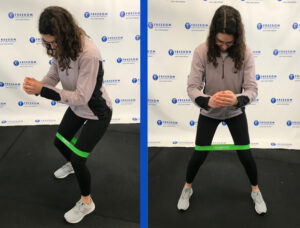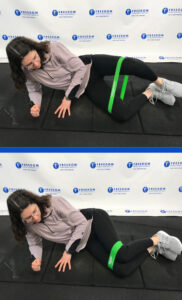Thursday, many of us will be glued to our television sets watching the NCAA basketball tournament. Even the most casual of fans can’t help but watch and be drawn into the excitement; the upsets and buzzer-beaters. Perhaps inspired by watching the tournament and (hopefully) warming of the weather some of you head out to your local court for some action.
At Freedom PT, we want you to enjoy time on the court and avoid injury. According to the National Athletic Trainers Association, below are the five most common basketball injuries. We will share some of our expertise on how to avoid injury on the court.
Foot/Ankle Injuries:
42% of all basketball injuries are to the ankle/ foot, with ankle sprains being the most common. With the amount of jumping, running and cutting that occurs in basketball, landing awkwardly or on someone else’s foot can cause ankle injuries.
Prevention: External ankle supports and high-top basketball shoes have been found to be effective at reducing the incidence of ankle injuries in basketball. Single leg balance exercises can help to improve your balance and prevent injuries.
Examples of single leg balance exercises:


Hip/Thigh Injuries:
11% of injuries in basketball are to the thigh/hip area. Due to the amount of running, jumping and cutting in basketball, muscle strains are fairly common. Muscle contusions also tend to occur as two players can run into each other while playing.
Prevention: A dynamic stretching warm-up before playing will help to decrease your chances of a muscle strain. Contact issues may be hard to prevent but compression shorts with thigh pads are now available. If a contusion does occur; Rest, Ice, Compression and Elevation (RICE) along with some gentle stretching can be helpful.
Example of a dynamic warm-up: (Perform each for 15-30 seconds)
- High Knees
- Butt Kickers
- Hamstring High Kicks
- Single leg deadlift (unweighted)
- Lunges
- Squats
- Jumping-Jacks
Wrist/Hand Injuries:
Approximately 11% of basketball injuries occur to the wrist/hand/forearm usually as a result of contact with another player or the ball.
Prevention: Keeping your head on a swivel and being aware are your best bet here. Watching the ball all the way into hands will help from getting your fingers jammed. If you happen to injure your hands or wrists playing, you can seek help from occupational therapists who specialize in treating the upper extremities.
Knee Injuries:
Knee injuries account for 9% of all basketball related injuries. Fortunately, significant knee injuries, such as ACL tears, are not as frequent in basketball as in other high-contact sports. In basketball, knee injuries tend to be of the sprain variety meaning the ligaments are not torn but stretched beyond their norm.
Prevention: I frequently tell my patients with knee issues that, “their butt is their knee’s best friend”. What I mean by this is the stronger we get their gluteus muscles the less strain there will be through their knees. So again, a good lower extremity stretching and strengthening program will go a long way to preventing knee injuries.
Exercises to strengthen glute muscles:


Head/Face Injuries:
An elbow to the head or two players diving for a ball and hitting heads are two likely scenarios for a head injury to occur.
Prevention: As with any head trauma, concern for a concussion is paramount. If any symptoms of a concussion are present contact your physician immediately.
An interesting fact from the National Athletic Trainers Association about basketball injuries is that approximately 60% of injuries occur in the second half of games. This suggests fatigue plays a role in injuries and shows the importance of a proper conditioning program before heading to the court.
If you are interested in learning more about proper exercises to decrease your risk of injury or would like to have one of our skilled therapists put together an individualized conditioning program, contact Freedom Physical Therapy Services at any of our locations, or make an appointment.

